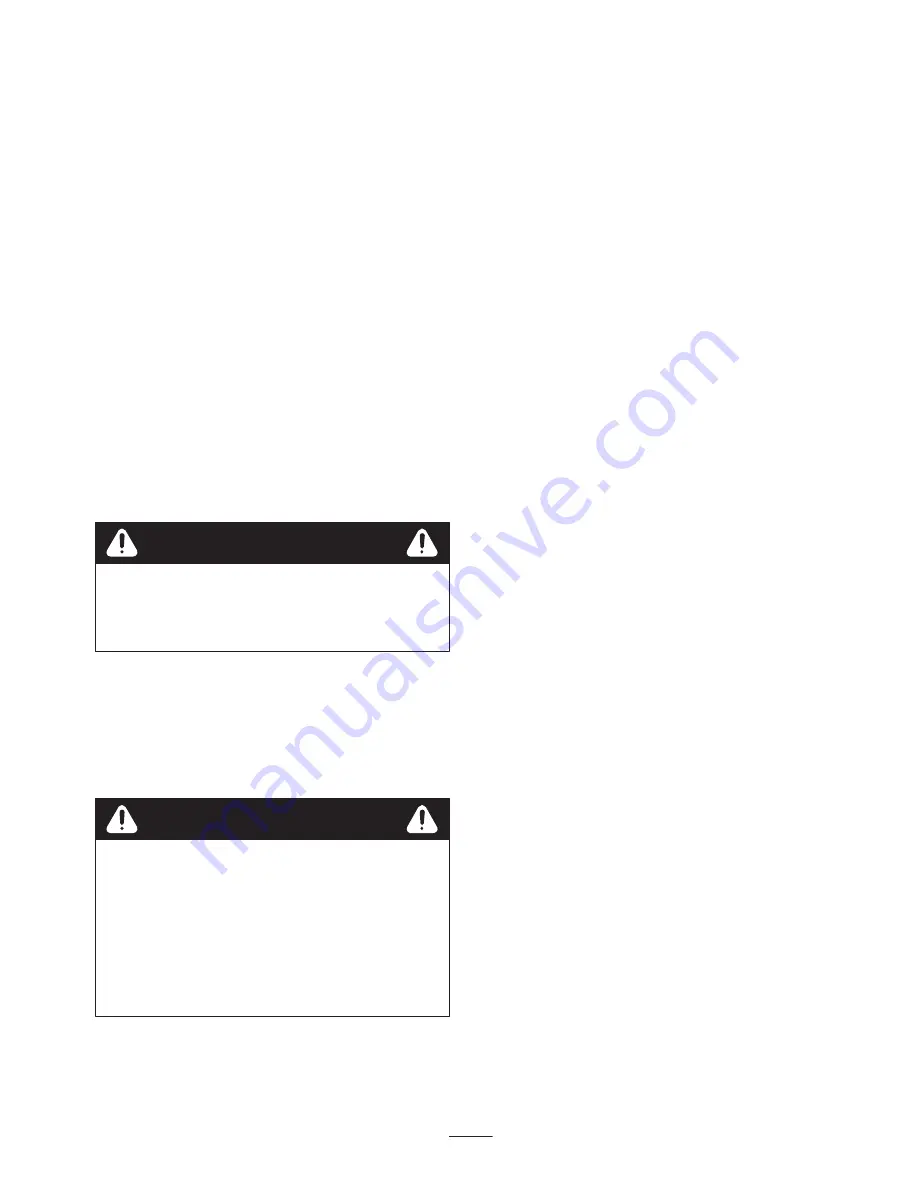
13
Operating Tips
•
Review the safety instructions and read this manual
carefully before operating the lawn mower.
•
Clear the area of sticks, stones, wire, branches, and
other debris that the blade could hit and throw.
•
Keep everyone, especially children and pets, away
from the area of operation.
•
Avoid striking trees, walls, curbs, or other solid
objects. Never deliberately mow over any object.
•
If the lawn mower strikes an object or starts to vibrate,
immediately stop the engine, disconnect the wire from
the spark plug, and examine the lawn mower for
damage.
•
Maintain a sharp blade throughout the cutting season.
Periodically file down nicks on the blade.
•
Replace the blade when necessary with an original
Exmark replacement blade.
•
Mow only dry grass or leaves. Wet grass and leaves
tend to clump on the yard and can cause the lawn
mower to plug or the engine to stall.
Wet grass or leaves can cause serious injury if you
slip and contact the blade.
Mow only in dry conditions.
Warning
•
Clean the underside of the lawn mower deck after each
mowing. See Cleaning the Underside of the Lawn
Mower Housing on page 15.
•
Keep the engine in good running condition.
•
Set the engine speed to the fastest position for the best
cutting results.
Operating a lawn mower with its engine running
at a speed greater than the factory setting can
cause the lawn mower to throw a part of the blade
or engine into the operator’s or bystander’s area
and result in serious personal injury or death.
•
Do not change the engine speed setting.
•
If you suspect the engine speed is faster than
normal, contact an Authorized Service Dealer.
Warning
•
Clean the air filter frequently. Mulching stirs up more
clippings and dust which clogs the air filter and
reduces engine performance.
Cutting Grass
•
Grass grows at different rates at different times of the
year. In the summer heat, it is best to cut grass at the 2
inch (51 mm), 2-1/2 inch (64 mm), or 3 inch (76 mm)
cutting height settings. Cut only about a third of the
grass blade at a time. Do not cut below the 2 inch (51
mm) setting unless the grass is sparse or it is late fall
when grass growth begins to slow down.
•
When cutting grass over 6 inches (15 cm) tall, first
mow at the highest cutting height setting and walk
slower; then mow again at a lower setting for the best
lawn appearance. If the grass is too long and the leaves
clump on top of the lawn, the lawn mower may plug
and cause the engine to stall.
•
Alternate the mowing direction. This helps disperse
the clippings over the lawn for even fertilization.
If the finished lawn appearance is unsatisfactory, try one
or more of the following:
•
Sharpen the blade.
•
Walk at a slower pace while mowing.
•
Raise the cutting height on your lawn mower.
•
Cut the grass more frequently.
•
Overlap cutting swaths instead of cutting a full swath
with each pass.
•
Set the cutting height on the front wheels one notch
lower than the rear wheels. For example, set the front
wheels at 2 inches (51 mm) and the rear wheels at
2-1/2 inches (64 mm).
Cutting Leaves
•
After cutting the lawn, ensure that half of the lawn
shows through the cut leaf cover. You may need to
make more than one pass over the leaves.
•
For light leaf coverage, set all the wheels at the same
cutting height setting.
•
If there are more than 5 inches (12.7 cm) of leaves on
the lawn, set the front cutting height 1 or 2 notches
higher than the rear cutting height. This makes it
easier to feed the leaves under the lawn mower deck.
•
Slow down your mowing speed if the lawn mower
does not cut the leaves finely enough.
•
If you mow over oak leaves, you can add lime to the
grass in the spring to reduce the acidity of the oak
leaves.
















































